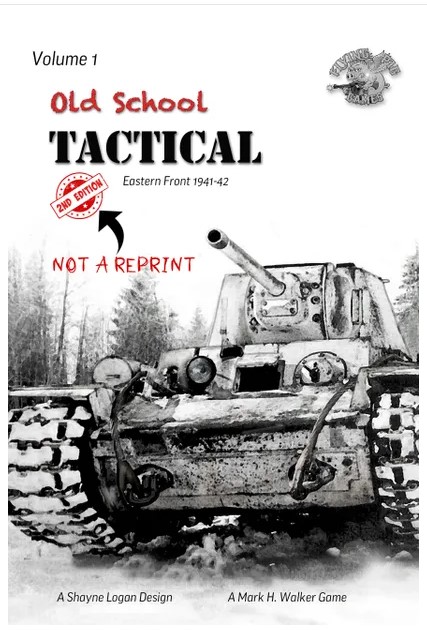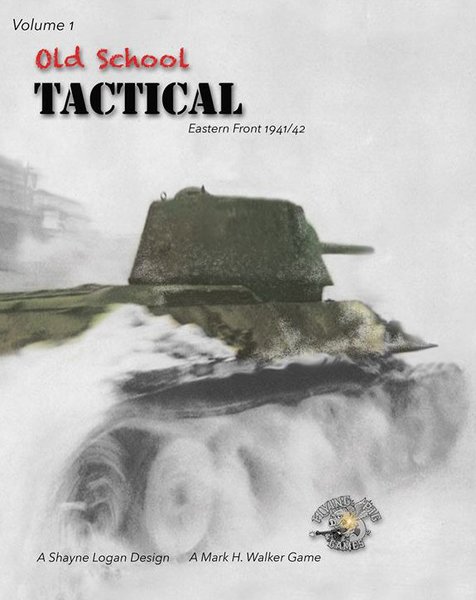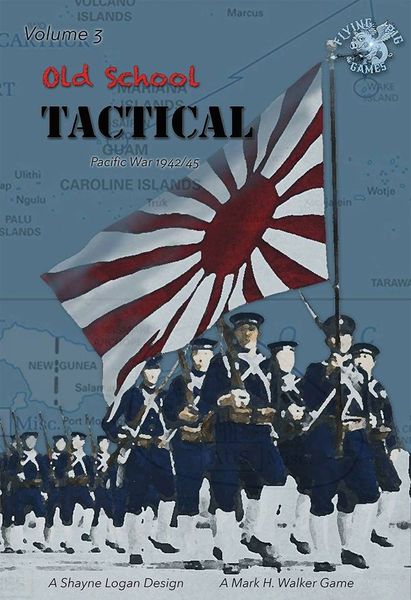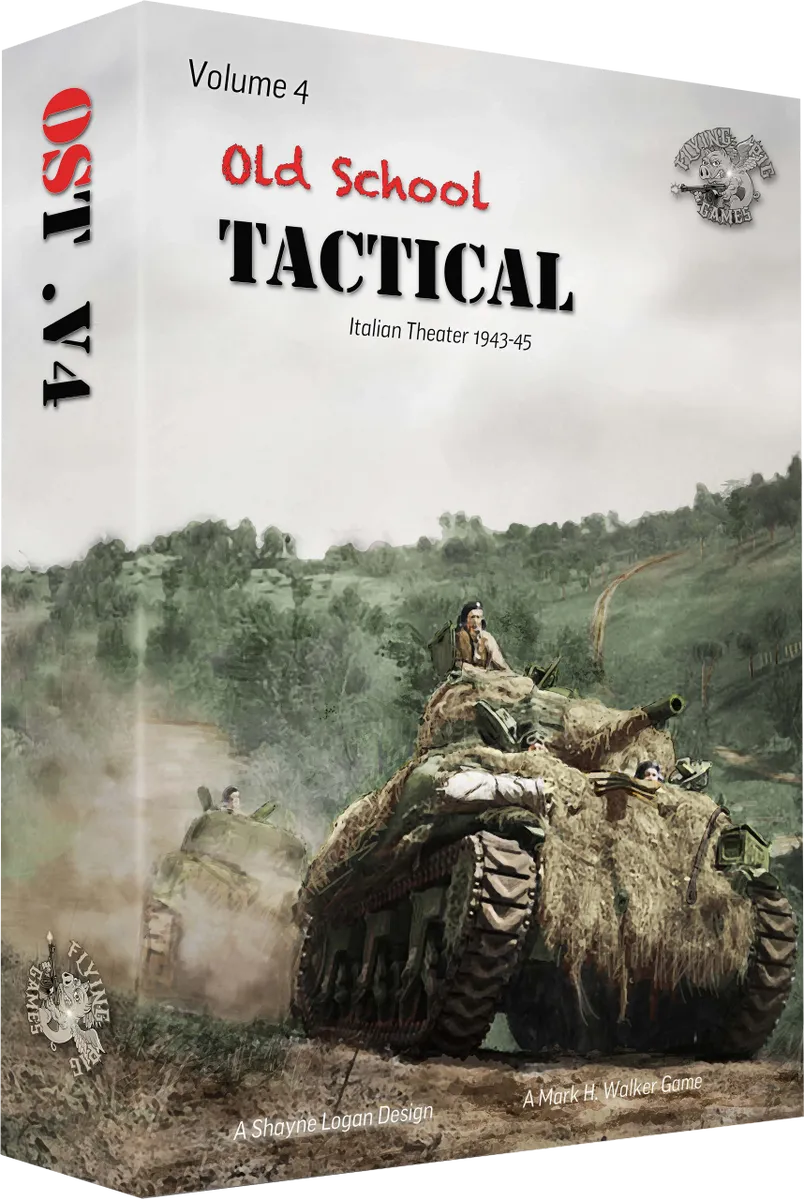Band of Brothers, The Pacific, The Things They Carried, The Naked and the Dead, I could go on, but you get the point: all of these are war narratives focused on the meat and potatoes of the military: the platoon. The grunts. The GIs. In war gaming, Combat Commander and Advanced Squad Leader have held the crown for the muddy, bloody close encounters fought by these soldiers. But a relative newcomer from Flying Pig Games is staking its own claim to a share of tactical-level war gaming, and its name, perhaps unsurprisingly, is Old School Tactical.
What Is Old School Tactical
Emerging in 2016 and receiving regular expansions since, Old School Tactical captures the spirit of, well, older war gaming while updating components, rules, and style to fit modern convenience. Packed in the system’s large boxes are mounted maps, thick die-cut counters, and solid booklets for rules, scenarios, and more. Just in the volume one set, which focuses on World War Two’s eastern front engagements, you’ll find sixteen scenarios to tackle.
 Jumping into these clashes is made easier thanks to a slim rule set—just a 21 page core rulebook covers everything from vehicles to elevation, line of sight to artillery strikes. Old School Tactical gets you close enough to realism without sending you through a series of fiddly steps every time you want to fire a mortar. You’ll still pile up modifiers for attacker and defender for things like cover, group fire, and specific weapons, but those calculations will come faster and easier than in its more complex brethren. This shines even more in solitaire play, as you’ll stay in the action.
Jumping into these clashes is made easier thanks to a slim rule set—just a 21 page core rulebook covers everything from vehicles to elevation, line of sight to artillery strikes. Old School Tactical gets you close enough to realism without sending you through a series of fiddly steps every time you want to fire a mortar. You’ll still pile up modifiers for attacker and defender for things like cover, group fire, and specific weapons, but those calculations will come faster and easier than in its more complex brethren. This shines even more in solitaire play, as you’ll stay in the action.
And the action is where Old School Tactical wants you to be.
See, the turn-by-turn gameplay here revolves around dynamic impulses. Players trade off these impulses one after another, but every round will see a different amount allocated by a die roll. Yep, you might roll into four points while your pal gets three, a random element that evens out over a scenario’s length but, in the moment, adds a real spark. A low roll forces you to consider what’s the key for that round, hunkering down or burning your points on a single squad’s advance, while a high roll might give you the opening you need to attack that objective. Impulse points are Old School Tactical’s core currency, and you’ll spend one to put a squad into cover, reinforce, fire, and do just about anything.
Using impulses is wide open and not dictated by a card draw or other elements, which makes every scenario, whether it’s a German retreat across a contested bridge or an armored clash on snowy fields, a dynamic duel. Taking a different approach than your opponent is eminently doable, and sometimes that approach is just going to be blasting them to smithereens.
Old School Tactical doesn’t flounce about with its combat tables. Units can and will take casualties. They’ll get eliminated. This isn’t a game that requires encirclement to knock a counter off the board, but rather rewards smart, steady engagement. Sitting in a defensive posture is difficult and prone to annihilation. Boring tactics, in other words, will see you chased from the field.
All these impulses, the moving of squads and small stacks around the battlefield, will come in service of familiar objectives. Capture this, destroy that, reach a point on the map. For anyone with a little wargaming experience, Old School Tactical will be an easy fit.
All in all, you’re getting a fluid, fun, tactical war game with most scenarios playable in a few hours or less, and one that comes with enough board presence and quality art to draw curious players to the table.
How to Get Started With Old School Tactical
It might seem obvious, but starting with any of the core Old School Tactical volumes is the way to go. For newbies, the second edition of volume one published in 2022 includes two tutorial scenarios designed to get you up to speed. Each of these comes with counters, huge mounted maps, and plenty of scenarios to enjoy. Each also covers a different WWII area:
Volume 1 – European theater, Eastern Front
Volume 2 – European theater, Western Front
Volume 3 – Pacific theater, islands and beaches
Volume 4 – European theater, Italy
As is the usual war gaming recommendation, picking the area you’re interested in is going to go best. All of these volumes include armored and infantry units, varied scenarios and objectives, dice, and anything else you need to play. You also don’t need, say, volume 1 to play volume 2 and vice versa.
Each volume also has expansion opportunities, like Stalingrad and Airborne for volume 1, or the Hell Bent expansion for volume 3 that brings in Okinawa, Wake Island, and more. If you know for sure you’ll want the whole thing, then you can save a bit of time, money, and effort by getting a whole collection, but otherwise it’s fine to pick these up as you go. I’ll say these are somewhat hard to find, though, so I’d recommend using the Want List to add any of these now so you can jump on them when they come in stock.
Flying Pig Games has also taken cues from more modern board game publishers and offers ways to add chrome through playmats, custom dice, and all sorts of nifty bits and bobs. These can make the play experience more fun, especially if you’re going to be spending a lot of time clashing with Old School Tactical (and why wouldn’t you?), so make sure to Want List any additions you’d like to grab when they airdrop back into the store.
Great Titles From Flying Pig Games
This is normally the part in the piece where I’d highlight similar games to Old School Tactical, but you already know them. They’re the heavy hitters, the classics, including the pair I noted at the start but also Conflict of Heroes and Undaunted. Dig in and find as much tactical game as you’ll ever need.
 So instead, because they’re cool and their games are cool, let’s dig a little deeper into Flying Pig Games, publishers of Old School Tactical. Aside from, of all things, producing mouse pads with nifty graphics for their games, Flying Pig has a few other titles that any war gamer ought to explore.
So instead, because they’re cool and their games are cool, let’s dig a little deeper into Flying Pig Games, publishers of Old School Tactical. Aside from, of all things, producing mouse pads with nifty graphics for their games, Flying Pig has a few other titles that any war gamer ought to explore.
First up is Armageddon War, a near future platoon-level game that generally pits factions like Israel and the US against Russia and other Middle Eastern adversaries. Innovations abound in this one, like a fluid activation system that doesn’t run on turns or ‘phases’. Unit formations, like, say, a group of M1 Abrams tanks, are assigned chits at the start of a scenario. All those chits get tossed in a bag (with everyone else’s) and the unit gets to activate when its chit is drawn.
So familiar, save the drawing happens from a combined bag, and when a formation’s last chit comes out, they’re all mixed back in. This effectively means the game keeps on rolling – odds will get flat over a game’s course, but this setup leads to a battle in constant motion, with heroic performances by some units arising naturally. It’s fast and compelling.
The combat is too, thanks to custom dice. CRTs are scrapped here, with dice color determining likelihood of hits, and those dice getting upgraded or downgraded based on various factors like range, whether the unit’s moved, and so on. It’s trading calculation for dice color vs. locating the right column on a table, but once you get the hang of it, the battles pack a meaty punch.
Armageddon War comes with fifteen scenarios in the base game, and these are unlike what you’ll find elsewhere. One side might play as terrorists attempting to detonate a bomb, another might have you deploying drones to seek out and destroy rebels. It’s both a shift from ‘the norm’ and a compelling way to experience more modern warfare. A number of expansions open up solitaire options and a persistent campaign too, getting you deep into this dangerous world.
That said, if these sorts of situations sound a little too serious, Flying Pig Games has The Long Road, another platoon-level game turning the clock back to the 80s. Yep, it’s a Cold-War-Gone-Hot setting, but here’s the twist: werewolves. Vampires. The Paranormal.
Did I lose you?
Hope not, because The Long Road’s twist on traditional war gaming is worth the experience. Yes, it comes with Flying Pig Games’ usual chrome (mounted maps, great illustrated counters), but the reason to dive in is the setting, the focus on soldiers and morale, and heroes. You’ll need to lead your squads, tanks, and, well, demons against opposing forces using a ruleset based on Platoon Commander.
You’ll get 27 scenarios in the core game, of which ten are pure tactical options with the paranormal bits stripped out if you prefer things more… grounded. Because of the WW3 setting, you’re getting unusual elements, like refugees to protect, rather than simpler ‘take this territory and win’ goals. All of them are an adventure for you and a pal to play (or run through solitaire), with the campaign in particular creating a light narrative different from what you’ll find elsewhere.
Because of the WW3 setting, you’re getting unusual elements, like refugees to protect, rather than simpler ‘take this territory and win’ goals. All of them are an adventure for you and a pal to play (or run through solitaire), with the campaign in particular creating a light narrative different from what you’ll find elsewhere.
I’d say The Long Road could serve, with its heroes and monsters, as a decent bridge to war gaming from someone more used to, say, Descent or Arena: The Contest. The rules here aren’t light, but are a far cry from war gaming’s heavy titles (this isn’t World in Flames with werewolves, people). The campaign can ease you in, and the rulebook provides plenty of friendly examples to help you get your footing. In any case, The Long Road is a supernatural war game worth playing, which is probably why it won 2022’s Charles S Roberts award for best science fiction or fantasy wargame.
Not a bad sign.
The takeaway, here, is that Flying Pig Games, like so many neat war gaming publishers, are creating fantastic, innovative titles that remix classic systems into fresh settings and styles. Don’t sleep on their games, because you’ll be missing out on excellent fun.
